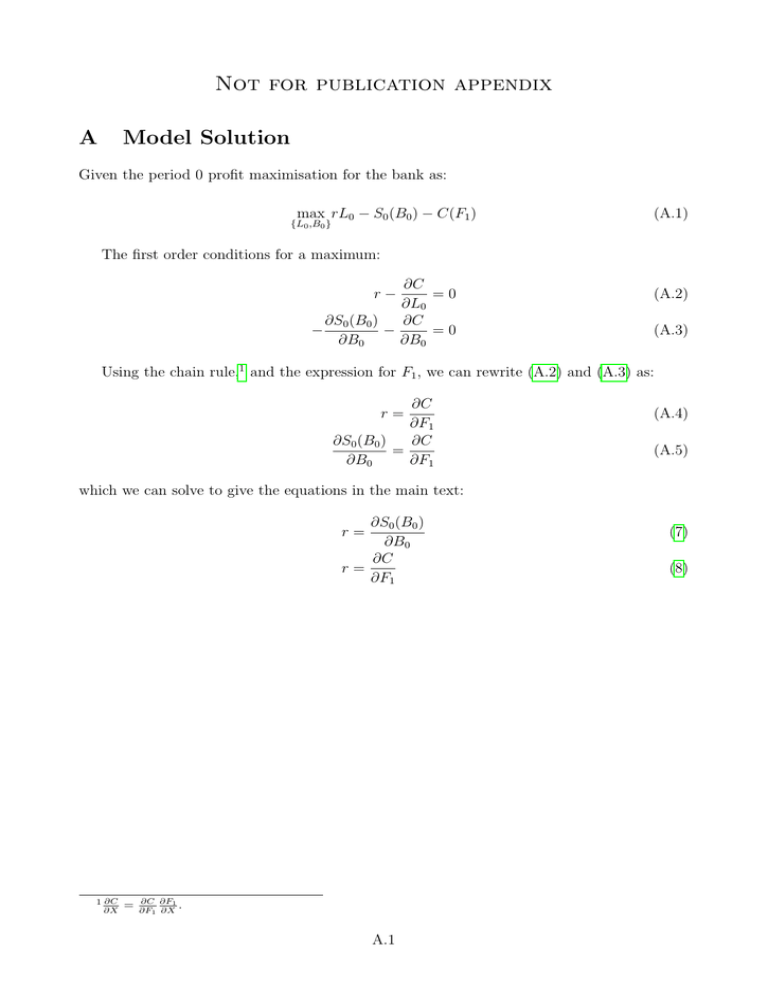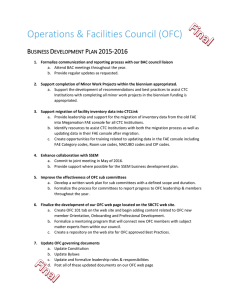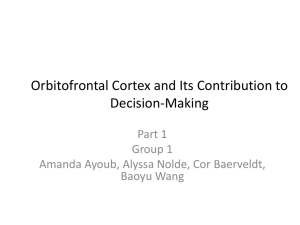Not for publication appendix A Model Solution
advertisement

Not for publication appendix
A
Model Solution
Given the period 0 profit maximisation for the bank as:
max rL0 − S0 (B0 ) − C(F1 )
{L0 ,B0 }
(A.1)
The first order conditions for a maximum:
∂C
=0
∂L0
∂C
∂S0 (B0 )
−
=0
−
∂B0
∂B0
r−
(A.2)
(A.3)
Using the chain rule,1 and the expression for F1 , we can rewrite (A.2) and (A.3) as:
∂C
∂F1
∂S0 (B0 )
∂C
=
∂B0
∂F1
r=
(A.4)
(A.5)
which we can solve to give the equations in the main text:
∂S0 (B0 )
∂B0
∂C
r=
∂F1
r=
1 ∂C
∂X
=
∂C ∂F1
∂F1 ∂X .
A.1
(7)
(8)
B
Robustness: Difference-in-Differences model
As a robustness exercise, we conduct another test of the BLC using an alternative approach
to identification. We follow much of the existing literature and use bank level differences to
uncover whether QE gave rise to a BLC. As we showed in the main text, QE represented
a large positive shock to the aggregate quantity of OFC, as opposed to other, deposits and
therefore we seek to exploit structural differences in banks’ OFC funding which capture the
degree to which they are likely to benefit from the increase in OFC deposits. Our alternative
hypothesis to try to identify evidence of a traditional BLC as a result of QE is:
Hypothesis B.1 QE boosted the aggregate level of OFC deposits which would lead banks with
capacity to absorb OFC deposits to increase lending via a bank lending channel.
We test this hypothesis using a diff-in-diff approach which exploits the fact that some
banks have the knowledge and technical infrastructure in place to handle large deposits by
financial market counterparties. These banks typically use OFC deposits as both a standard
and a marginal funding source and they would be comfortable accepting large OFC deposits.
Other banks would be less able to accept large OFC deposits. Accordingly we split our sample
into two sets of banks - one group who are likely to be subject to large exogenous deposit
shocks as a result of QE, and another group who are unlikely to be subject to such shocks.
We call the former group ‘OFC funders’ and we call the latter group of banks, who may still
use OFC deposits as a marginal funding source, ‘non-OFC funders’. We can then look at
the change in the behaviour of these banks when the QE-induced increase in OFC deposits
occurs. The idea is that funders are exogenously affected by the generation of OFC deposits
from APF activity and therefore a traditional BLC as a result of QE would, other things
being equal, equate to higher relative lending for funders after the beginning of QE.
Specifically, we identify OFC funders and non-OFC funders by the peak share of OFC
funding in the period leading up to March 2009, when QE1 started; those with a peak share
of less than 12.5% are classified as ‘non-OFC funders’. We use the peak in order to capture
capacity to use OFC as a funding source. We choose the cut-off of 12.5% because it effectively
divides the sample in half though we have checked that our results are robust to a number of
other choices of cut-off. We therefore define:
1 OF C f under
D(F under)i =
(B.1)
0 otherwise
Table B.1 shows that whether a bank was a large OFC funder is not simply capturing
the bank being a gilt participant (through which APF transactions could take place) as was
important in the identification used in the main text. This means that the diff-in-diff analysis
is picking up an alternative split of the banks.
A.2
Table B.1: Cross-tabulation of OFC funders and gilt participants
D(OFC funder)
0
1
Total
D(Gilt participant)
0
1
8
3
8
6
16
9
Total
11
14
25
Notes: This table shows, for the 25 banks in our QE-period sample, how they breakdown between
being banks that are participants in the APF gilt auctions (D(Gilt participant)=1) and being
those banks identified as having capacity to adsorb OFC funds ((D(Funder)=1).
Our diff-in-diff test is to check whether, controlling for a number of bank level determinants
of lending growth, funders have higher lending growth than non-funders after the start of QE.
We estimate, in the most parsimonious case, a regression of:
∆Li,t = αi + τt + δD(QE)t + γ1 ∆Li,t−1 + φ1 Xi,t + β0 D(F under)i × D(QE)t
... + λ0 ∆Di,t−1 + i,t
(B.2)
where ∆Li,t is the change in lending to households and PNFCs, D(QE)t is a dummy variable
equal to one after the policy of QE was introduced in March 2009, and Xi,t contains a
number of potentially important controls which we discuss below. The coefficient β0 captures
the extent whether OFC funders lending growth was, on average, larger or smaller after the
introduction of QE. A BLC should give rise to a positive β0 .
All regressions include bank fixed effects (αi ) to capture the average lending of each bank.
We will report some results that include time fixed-effects (τt ), and some that do not. The Xi,t
controls include the lagged value of the overall credit stock, the contemporaneous customer
funding gap, holdings of liquid assets and sector demand.
Since all types of banks might use OFC deposits as a marginal funding source, the coefficient λ0 is included to pick up the correlation between deposits and lending that might be
driven by banks that want to lend more increasing their marginal funding (including OFC
deposits). To measure the extent to which funders actually used OFC deposits more (or less)
in the QE period, we also estimate the extended equation:
∆Li,t = αi + τt + δD(QE)t + γ1 ∆Li,t−1 + φ1 Xi,t + β0 D(F under)i × D(QE)t + λ0 ∆Di,t
... + λ1 D(QE)t × ∆Di,t + λ2 D(F under)i × D(QE)t × ∆Di,t + i,t
(B.3)
Here λ1 captures the fact that the period of QE may have led to changes in the typical use of
OFC as a marginal funding source. The λ2 coefficient allows there to be a differential change
in behaviour for our funder banks.
Since our identification, under both regression models, relies on the two groups being
homogenous apart from their OFC funding share, we now examine whether this is the case.
A.3
Table B.2: Summary statistics for OFC funding split
Capital buffer
D(Funder)i = 0
5.8
D(Funder)i = 1
4.7
Total liabilities
45587
56386
Real economy lending
2266
9099
8.3
14.7
Liquid assets
Notes: Medians by group.
Table B.3: Probit to predict D(Funder)
Total liabilities
Real economy lending
Liquid assets
Capital buffer
Observations
Chi-squared
D(Funder)i = 1
-0.000
(0.000)
0.000
(0.000)
-0.019
(0.056)
-0.088
(0.183)
17
12
Notes: Standard errors are reported in parenthesis. *** p<0.01, ** p<0.05, * p<0.1. Estimation
using bank means calculated over 2004-2009
Table B.2 provides an overview of the characteristics of the banks in the two splits. The
main difference between the two groups is their size, both in terms of their real economy
lending and total liquid assets. Despite these differences, Table B.3 shows the results of
a probit estimation on the D(Funder) variable and shows that the membership of the OFC
funder group is is not predictable based on these observable characteristics.
Given that we find evidence that OFC funders and non-funders are similar in other characteristics, there is no obvious reason to reject our identifying assumption. We therefore
proceed to test our BLC hypothesis using this diff-in-diff approach: under a BLC, funders
should increase loans to households and PNFCs by more than that of non-funders, which
means that β0 > 0 would be evidence in support of the traditional BLC under either (B.2)
and (B.3). Table B.4 shows the estimation results when we use monthly data over the period
starting in February 1989 to January 2013. The set threshold that separates OFC funders
from non-OFC funders is set to 12.5% as described above and we exclude banks for which we
have less than ten observations. We use standard errors which are clustered at the bank level
A.4
to compute significance levels to take account of heterogeneity across banks.
The first column of Table B.4 presents the results from estimating equation (B.2) while
column (2) presents the estimation of equation (B.3). Columns (3) and (4) replicate (1) and
(2) respectively but with the addition of a variety of additional lags. As described above, a
BLC should show up as a positive estimate of β0 , the coefficient on the D(Funder)i ×D(QE)t
variable. We find, consistent with the results of the most parsimonious model using the
IV approach, that the coefficient on this interaction term is negative though not usually
statistically significant. This, if anything, points to a negative BLC which could be driven be
the fact that OFC deposits may have increased in aggregate, but they may have also become
a less stable source of funding for banks.
In some of the specifications we find a positive coefficient on ∆OFC depositst (λ0 ), though
the coefficient is economically small. Given that banks that want to lend may demand OFC
deposits as a marginal funding source, we would expect this reverse causation to lead to such a
finding; as such, we do not think that this positive coefficient reflects a BLC. When we estimate
equation (B.3) in columns (2), (4) and (5), we allow this relationship to change after QE, and
to allow this change in coefficient to change differentially for funder and non-funder banks as
captured by the coefficients on D(QE)t × ∆OFC depositst (λ1 ) and D(Funder)i ×D(QE)t ×
∆OFC depositsi,t (λ2 ).2 While these specifications do not alter our finding in terms of no
evidence of a BLC, the relationship between OFC deposit flows and lending seems to have
changed with QE. In the post QE period, the average relationship seems to have weakened
across the non-funder banks (and especially at one lag) though the relationship does not
seem to have changed for the funder banks (λ1 and λ2 offset each other).3 This, like the
earlier results, is consistent with OFC deposits becoming a less stable source of funding for
non-funder banks, though the increase in the amount of OFC deposits may have offset the
increase in the churn for the funder banks.
We have carried out a number of robustness tests on these regressions but in the interests
of space we shall simply report what we found. We have carried out all of the analysis omitting
time-effects (one of these specifications is reported in column (5) of Table B.4. The results
are also robust to varying the threshold for being a funder to values between 5% (a very low
threshold) and 20% (making funder a more exclusive classification). Finally, we use a less
stark measure of the treatment. Instead of setting the treatment to one for funders after the
beginning of QE, we recognise that the extent to which OFC deposits were created depends
on the quantity of asset purchases made by the MPC. Therefore, we replace D(QE)t with
AP Ft , a variable which measures of the amount of assets purchased and therefore varies over
the QE period. The results in terms of the BLC are unchanged.
2
We have also run these regressions allowing the pre-QE relationship to differ between funder and nonfunder banks. As we find no difference, we do not report the regressions in the paper.
3
A specification that includes only D(QE)t × ∆OFC depositst finds that on average the relationship has
weakened slightly.
A.5
Table B.4: Difference-in-differences estimation
D(Funder)i ×D(QE)t
D(QE)t
∆Li,t−1
(1)
-167.608**
(80.853)
-
(2)
-155.171*
(78.840)
-
(3)
-104.825*
(61.032)
-
(4)
-103.211
(62.239)
-
0.378***
(0.072)
0.378***
(0.073)
-0.013
(0.027)
0.002
(0.002)
0.041
(0.041)
0.000
(0.001)
0.010
(0.007)
-0.013
(0.027)
0.002
(0.002)
0.043
(0.041)
0.000
(0.001)
0.032*
(0.016)
0.287***
(0.057)
0.165***
(0.033)
0.108***
(0.034)
-0.026
(0.024)
0.001
(0.002)
0.029
(0.041)
0.000
(0.001)
0.008
(0.008)
0.009***
(0.002)
-0.005
(0.005)
-0.007
(0.005)
0.282***
(0.056)
0.173***
(0.029)
0.112***
(0.035)
-0.027
(0.024)
0.001
(0.002)
0.030
(0.041)
-0.000
(0.001)
0.031*
(0.019)
0.008
(0.008)
-0.017
(0.013)
-0.023**
(0.011)
-0.035
(0.022)
-0.043***
(0.007)
-0.014
(0.016)
0.003
(0.020)
-0.002
(0.012)
0.044***
(0.010)
0.033***
(0.010)
0.021
(0.017)
Yes
Yes
5948
55
43
∆Li,t−2
∆Li,t−3
Sector demandi,t
Credit stocki,t−1
Customer funding gapi,t
Liquid assetsi,t
∆OFC depositsi,t
∆OFC depositsi,t−1
∆OFC depositsi,t−2
∆OFC depositsi,t−3
D(QE)t × ∆OFC depositsi,t
-0.023
(0.020)
D(QE)t × ∆OFC depositsi,t−1
D(QE)t × ∆OFC depositsi,t−2
D(QE)t × ∆OFC depositsi,t−3
D(Funder)i ×D(QE)t × ∆OFC depositsi,t
-0.011
(0.010)
D(Funder)i ×D(QE)t × ∆OFC depositsi,t−1
D(Funder)i ×D(QE)t × ∆OFC depositsi,t−2
D(Funder)i ×D(QE)t × ∆OFC depositsi,t−3
Bank fixed effects
Time fixed effects
Observations
Banks
F
Yes
Yes
6191
55
3
Yes
Yes
6191
55
4
Yes
Yes
5948
55
39
(5)
-66.026
(46.998)
-0.860
(14.485)
0.265***
(0.058)
0.171***
(0.028)
0.108***
(0.035)
0.057***
(0.015)
0.000
(0.002)
0.001
(0.011)
0.001
(0.001)
0.031
(0.018)
0.007
(0.009)
-0.018
(0.013)
-0.023**
(0.011)
-0.037**
(0.018)
-0.036***
(0.010)
-0.009
(0.017)
0.008
(0.020)
0.001
(0.007)
0.041***
(0.008)
0.029***
(0.010)
0.015
(0.018)
Yes
No
6086
55
129
Notes: Standard errors clustered at the bank level are reported in parenthesis. *** p<0.01, **
p<0.05, * p<0.1. Estimation period: February 1989 to January 2013. D(Funder) is equal to 1
for institutions with maximal OFC funding share > 12.5% in the five years prior to QE, and
zero otherwise. The results are robust to varying the threshold for the dummy between 5-20%.
A.6
Overall, our test of hypothesis B.1 suggests that QE, via an increase in the aggregate
level of OFC deposits, did not lead banks with capacity to absorb OFC deposits to increase
lending to households and PNFCs. That is, we find no evidence of a BLC.
A.7




